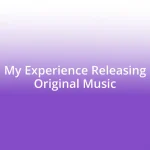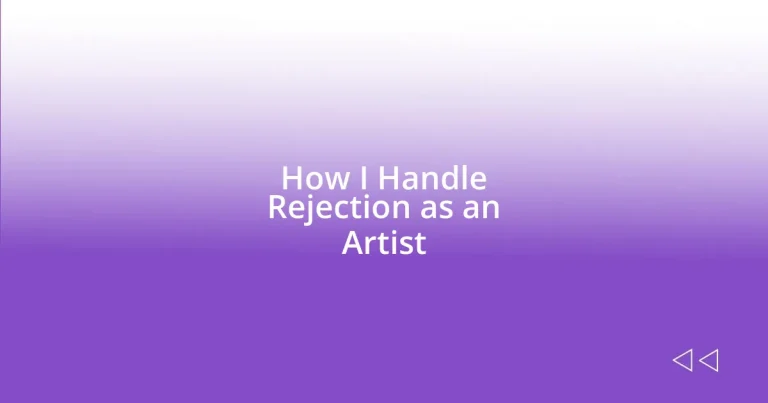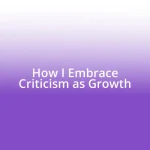Key takeaways:
- Rejection is subjective and a common experience among artists; viewing it as feedback fosters growth.
- Emotional acceptance of rejection is crucial; it validates passion and encourages support from the artistic community.
- Practicing self-compassion and seeking constructive feedback can transform setbacks into opportunities for improvement.
- Moving forward involves reframing rejection, setting small goals, and reflecting on experiences to gain clarity and motivation.
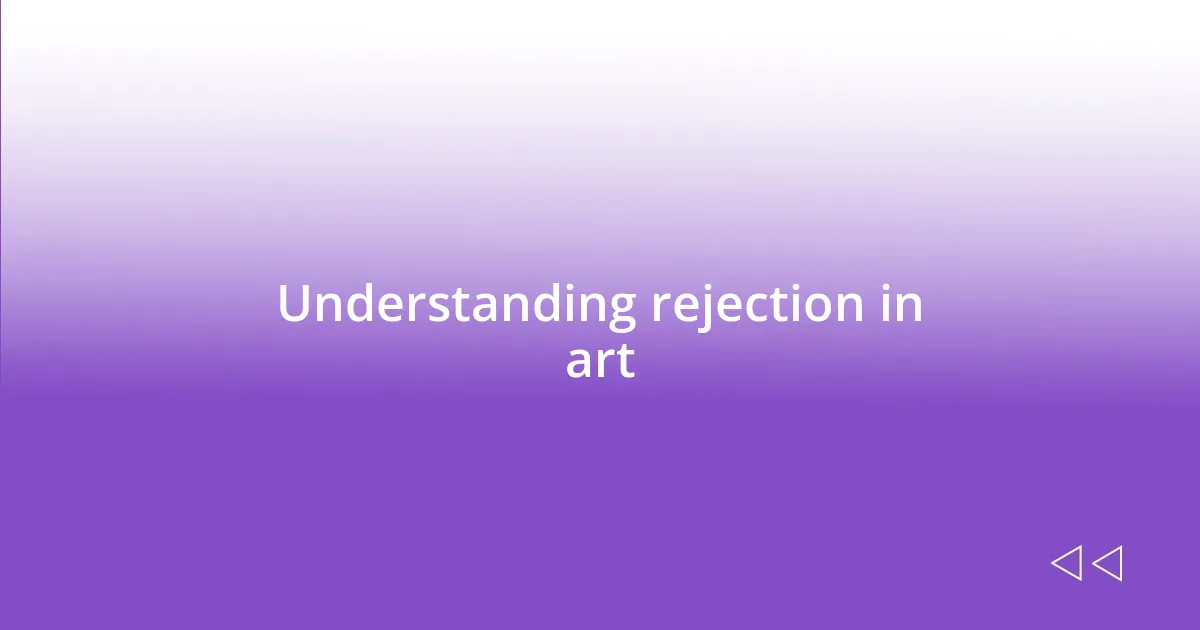
Understanding rejection in art
Rejection is a fundamental part of the artistic journey. I vividly remember my first experience when a gallery declined to exhibit my work—each word in the rejection email felt like a small stab to my creative soul. However, I came to realize that this moment wasn’t an end but a chance for reflection and growth.
As artists, we often pour our emotions and personal experiences into our work, making rejection feel intensely personal. I once showed a piece that I believed captured a pivotal moment in my life, only to have it dismissed as “just another canvas.” It was hard not to internalize that feedback, but I learned to shift my perspective—what if their opinion simply wasn’t aligned with my vision?
Understanding that rejection is subjective helps me to navigate these waters more smoothly. It’s essential to remember that every artist faces it, from emerging creators to seasoned professionals. I now view rejection as a signal to look deeper at my work and ask myself, “What can I learn from this?” This mindset has transformed my approach, turning a painful experience into a stepping stone for growth.
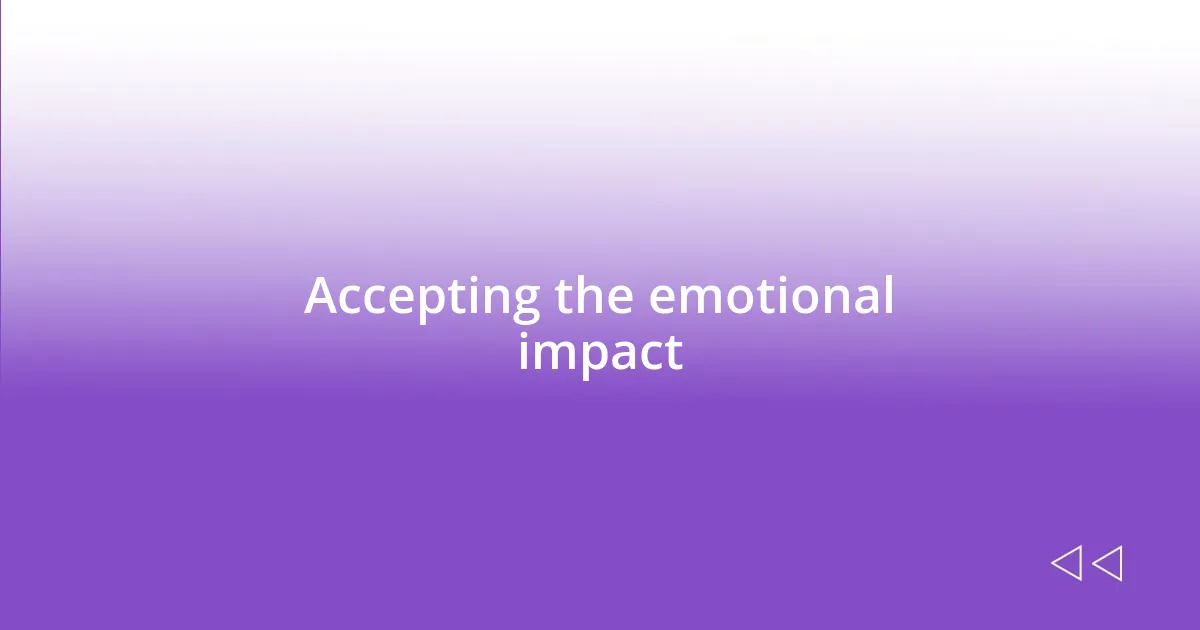
Accepting the emotional impact
Accepting the emotional impact of rejection is no small feat. I’ve felt the weight of disappointment more times than I care to admit. One particular instance stands out. After sharing my latest piece at a local show, I overheard someone say, “It’s interesting, but not for me.” While it stung at first, I took a moment to breathe. Acknowledging my feelings was crucial. I realized that feeling hurt validated my passion; it was proof that I cared deeply about my art.
- Recognize your feelings: Allow yourself to feel hurt, angry, or confused when facing rejection.
- Reframe the narrative: Instead of viewing rejection as a failure, see it as feedback for growth.
- Find support: Share your experience with fellow artists—community can be incredibly healing.
- Reflect on your journey: Journaling your thoughts can provide clarity and help process emotions.
- Celebrate small victories: Acknowledge positive feedback and personal achievements amidst rejections.
Accepting the emotional toll rejection takes involves embracing that complexity. If I walk away feeling raw, I remind myself that it’s OK to take a break. For me, creating art is about the process, and I’ve learned that accepting rejection’s emotional impact is part of that process. Each refusal has, in its own way, shaped the artist I am today.
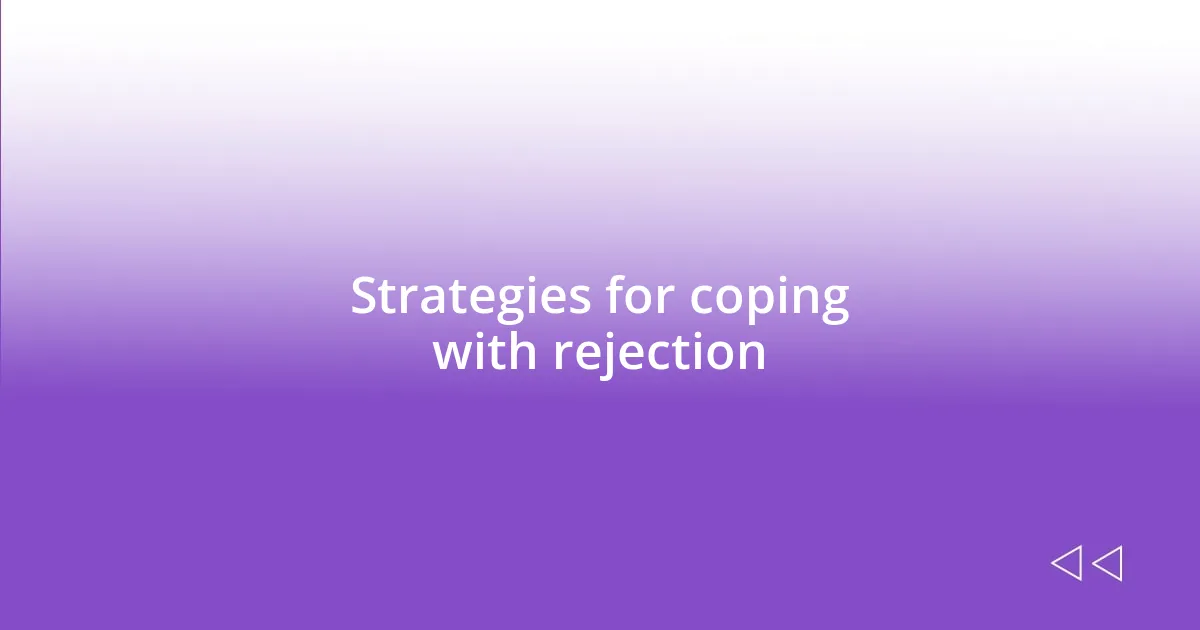
Strategies for coping with rejection
When coping with rejection, one strategy that has worked wonders for me is practicing self-compassion. I remember a time when I faced multiple rejections in a row, and it felt like my creative spark was dwindling. Instead of harshly criticizing myself, I began to treat my emotions with kindness, as if I were speaking to a friend. I realized that, just like any journey, my artistic path would have its share of ups and downs. Embracing my vulnerability made me feel lighter and more resilient.
Another effective approach is to seek constructive feedback. In one instance, after a particularly tough rejection, I gathered a small group of trusted artist friends and asked for their insights on my rejected work. The open dialogue we had about my piece helped me see it from different perspectives. Their suggestions inspired me to revise and improve upon my work, turning what felt like a setback into an opportunity for improvement and collaboration. I encourage you to consider the perspectives of others, it can be enlightening.
Lastly, I find that immersing myself in new projects can be incredibly liberating. Following a rejection, I often redirect my energy into creating something entirely different—perhaps a new painting or writing piece. This approach acts as a creative detox, reminding me that there’s always another canvas waiting for my passion. Embracing the idea of continuous creation helps me put rejection into context, as it does not define me but rather fuels my artistic evolution.
| Strategy | Description |
|---|---|
| Self-Compassion | Treat yourself with kindness, acknowledging your feelings without harsh judgments. |
| Seeking Feedback | Engage with trusted peers for constructive insights; it can enhance your work significantly. |
| New Projects | Redirect energy into fresh creative endeavors, helping you see rejection as a part of the journey. |
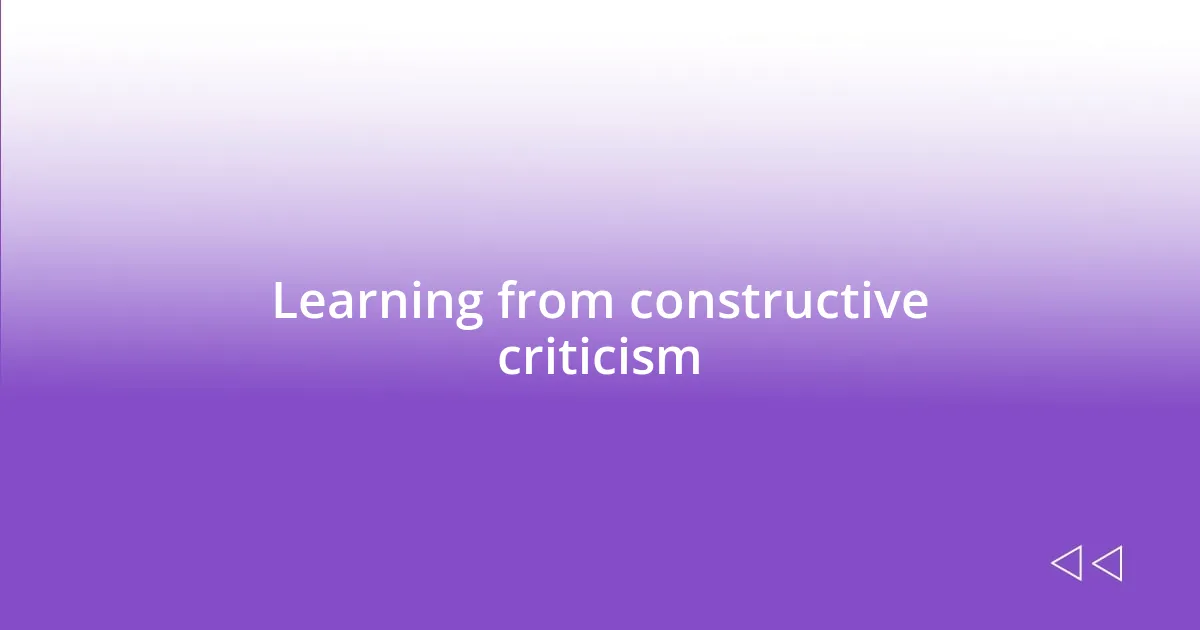
Learning from constructive criticism
Learning from constructive criticism is a vital part of my artistic journey. I remember showing a piece I considered my best work to a mentor, only to hear, “There’s potential, but you need to dig deeper.” Initially, I felt defensive—who wouldn’t? But I learned to view that feedback not as a rejection but as a roadmap for improvement. Have you ever had a similar experience? It’s in those honest conversations that we can find the seeds of growth.
I’ve found that separating my identity from my work helps me extract value from criticism. After receiving some tough feedback on a series of paintings, I took some time to reflect and asked myself, “What can I take away from this?” I started embracing the idea that each opinion is an opportunity to evolve. This shift in mindset made all the difference. Instead of feeling crushed, I felt empowered to experiment and expand my artistic vocabulary.
Constructive criticism can truly guide us toward our best selves as artists. I once collaborated on a project with a group of talented peers, where we critiqued each other’s work. The insights I gained from observing their unique approaches profoundly transformed my perspective. It made me realize that feedback isn’t just about what’s wrong; it’s about what can be better. Often, it’s the very things we’re too close to see that require external eyes to illuminate.
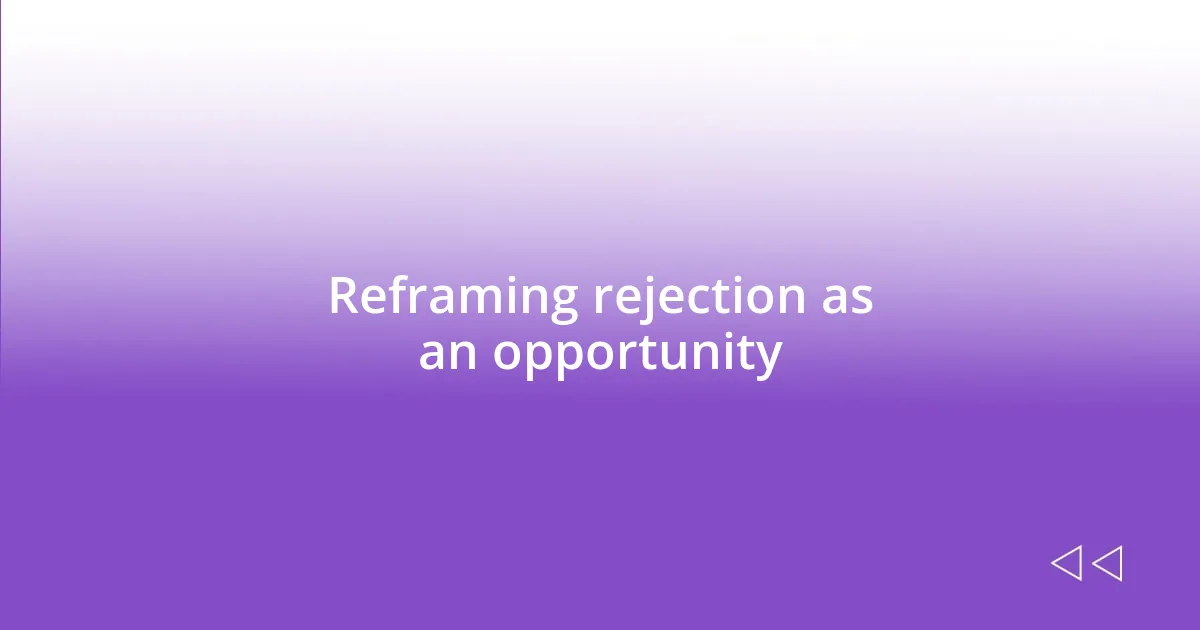
Reframing rejection as an opportunity
Reframing rejection as an opportunity can be a game-changer in an artist’s life. I distinctly remember a time when my submission to an art show was declined. Instead of sulking, I asked myself a crucial question: “What can I learn from this?” I took a step back and used that rejection as a catalyst to explore new themes and ideas in my work. This mental shift truly opened doors I didn’t even realize were there.
Pondering on rejection often reminds me of a conversation I had with a fellow artist after a disappointing showcase. They encouraged me to think of rejection not as a wall, but as a doorway leading to new artistic adventures. Inspired, I decided to dive into a collaborative project I had long put off. That experience not only sparked my creativity but also fostered a sense of community I hadn’t anticipated, turning what could have been a blow to my confidence into an enriching journey.
It’s fascinating how rejection, when viewed through a different lens, can morph into a powerful motivator. I once worked on a series of pieces that didn’t resonate with an audience I had expected to impress. Initially, I felt disheartened. But then, I used that feedback to fuel a more personal project, one that spoke directly from my heart. In the end, I realized that the most authentic expressions often emerge from moments of vulnerability and introspection. Isn’t it empowering to know that rejection doesn’t just end a path; it can also redirect it to something extraordinary?
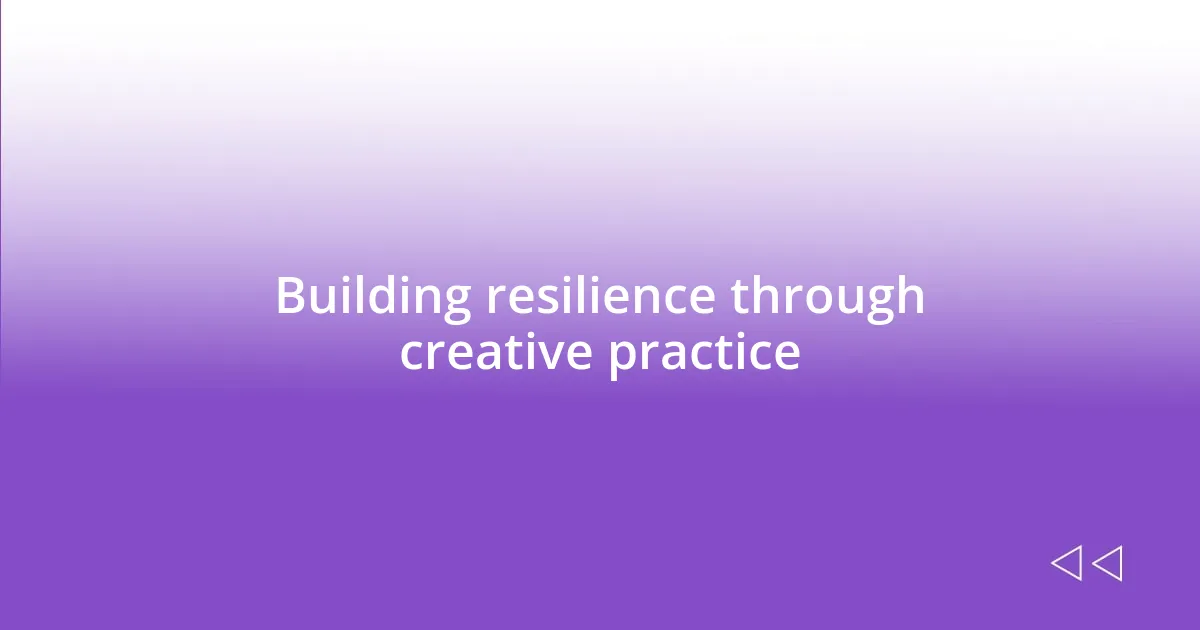
Building resilience through creative practice
Building resilience as an artist often comes down to embracing the creative practice itself. I remember a period when I was knee-deep in a challenging project that just wasn’t coming together. Instead of forcing it to fit my initial vision, I allowed myself to play and experiment, focusing on enjoying the process rather than achieving perfection. Have you ever let go of the outcome and found that space to explore? That moment taught me that resilience thrives in the act of creating, regardless of the end result.
Finding joy in routine practices is another way I’ve developed resilience. I used to feel disheartened when ideas didn’t pan out. However, I introduced regular sketching sessions into my week. Those sessions became a sanctuary for free expression, where judgment was left at the door. They allowed me to reconnect with my artistic voice and instilled a sense of confidence in my abilities. The act of creating without pressure has not only boosted my creativity but also fortified my resolve against the setbacks I inevitably encounter.
In moments of rejection, I remind myself of the creative community surrounding me. Joining local art groups helped me realize that many artists share similar struggles. During one meeting, an artist shared their story of a failed exhibition, and it felt so familiar. I realized that we all navigate these choppy waters together. How reassuring is it to know that our journeys are shared? By nurturing connections with others, I discovered that resilience can be contagious, and together we can transform rejection into collective growth.

Moving forward after rejection
Moving forward after rejection requires a conscious effort to shift our perspective. I recall submitting a piece to a prestigious competition only to receive a curt rejection email. Instead of letting it consume me, I chose to see it as an opportunity to refine my technique. That moment of realization prompted me to enroll in a workshop I had been eyeing, and it was a transformative experience. Have you ever found yourself overly attached to a single opportunity? Sometimes, the paths we least expect open up to us when we let go.
One practical approach I adopted involved setting small, achievable goals post-rejection. After facing criticism on my recent work, I decided to create a series focused on experimenting with colors I had previously shied away from. Each piece became a playground for exploration rather than a test of perfection. This change in mindset not only reignited my passion for creating but also helped me break free from self-imposed limitations. Isn’t it liberating to think that each setback can be a springboard into uncharted creative territory?
Additionally, I’ve learned the importance of reflecting on my experiences. After each rejection, I take a moment to journal about what I felt and the lessons learned. By putting my thoughts on paper, I can validate my emotions and celebrate my growth. The reflection often leads to insights I hadn’t considered before. Have you ever written about your own experiences? Making sense of rejection through reflection has been a game-changer for my artistic journey, allowing me to move forward with renewed clarity and determination.




